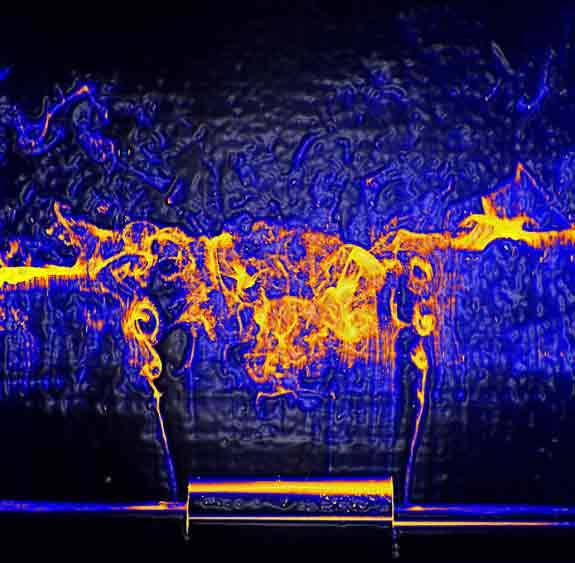Plethora of Vortices in the Wake of a Dual-Step Cylinder
Chris Morton
Serhiy Yarusevych
Department of Mechanical and Mechatronics Engineering
University of Waterloo
Waterloo, Canada

Image Credit: C. Morton and S. Yarusevych (University of Waterloo, Canada)Figure 1.

Image Credit: C. Morton and S. Yarusevych (University of Waterloo, Canada)Figure 2.
A plethora of vortices (orange) in water, created by a flow of water around a cylinder with two step changes in diameter. The length of the larger cylinder in Figure 1 is three times the size of its diameter, while the length of the larger cylinder in Figure 2 is equal to its diameter.
The images illustrate flow development for a dual-step cylinder, a cylinder with two step changes in diameter. The cylinder model is oriented horizontally at the bottom of each image and the water flow is upwards. The images depict a plethora of vortices (seen in orange) that develop as water flows around the dual-step cylinder.
The images show how the distance between the two step changes in diameter alter the topology of the flow, with other geometric parameters kept constant. In both images, the larger cylinder (bottom center) has twice the diameter of the smaller cylinder (bottom left and right). The length of the larger cylinder in the first image is three times the size of its diameter, while the length of the larger cylinder in the second image is equal to its diameter.
The first image depicts one vortex oriented horizontally, along the span of the cylinder (and called a "spanwise vortex"), as well as smaller-scale vortices emanating from each of the two steps in diameter. The image shows that the spanwise vortex deforms significantly behind the portion of the cylinder with larger diameter. The smaller scale vortices appear as a sequence of orange swirls that grow in size with distance from the cylinder.
The second image shows two spanwise vortices. Here, the distance between the step changes in diameter is reduced, which leads to less significant deformation of spanwise vortices. In addition, no evidence of smaller-scale vortices emanating from the steps can be seen.
The visualization is achieved with a hydrogen bubble technique. A DC voltage is applied to a small-diameter stainless steel wire mounted upstream of the cylinder model. This leads to the formation of hydrogen bubbles on the wire, which are carried away by the water flow. A conical laser beam is used to illuminate the hydrogen bubbles, thereby visualizing flow development.
Reporters and Editors
This image can be freely reproduced with the accompanying credit: "C. Morton and S. Yarusevych (University of Waterloo, Canada)."
Author Talks at the 2012 DFD Meeting
- D14.00006 Reconstructing dominant three-dimensional flow structures in the wakes of cylindrical bodies using planar velocity measurements
- L12.00009 Influence of diameter ratio and aspect ratio on wake development of a dual step cylinder
Contact Information
Chris Morton
Serhiy Yarusevych
Fluid Mechanics Research Laboratory
Mechanical and Mechatronics Engineering
University of Waterloo
Waterloo, Ontario, Canada
Phone: (519) 888-4567 x35442
Fax: (519) 885-5862
E-mail: syarus@uwaterloo.ca
Web: http://www.fmrl.uwaterloo.ca
